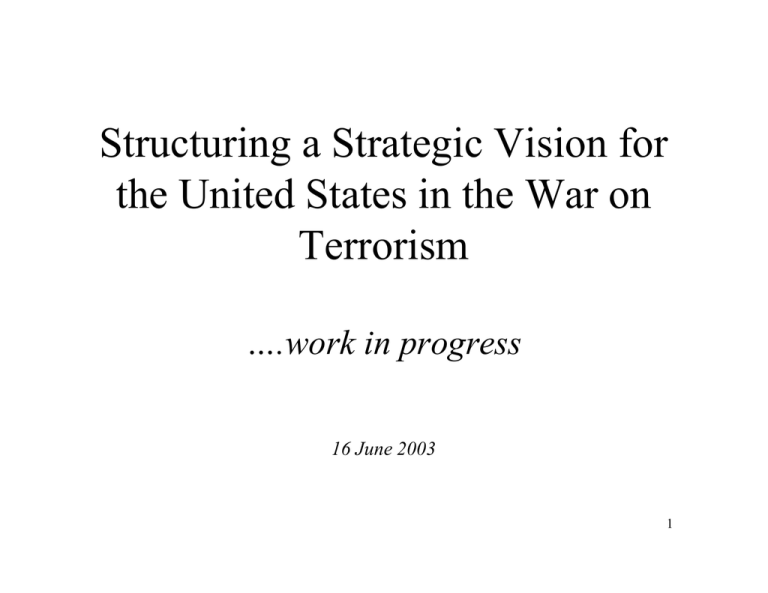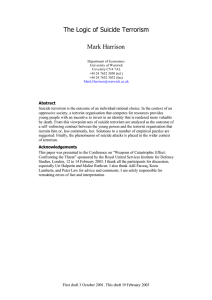Structuring a Strategic Vision for Terrorism ….work in progress
advertisement

Structuring a Strategic Vision for the United States in the War on Terrorism ….work in progress 16 June 2003 1 Define “Strategic”… …in the Context of the War on Terrorism “Strategic” from from the the Dictionary: Dictionary: “Strategic” • Of great importance to an integrated whole; striking at the sources of an enemy’s military, economic, or political power. Webster’s New-Collegiate Dictionary • Essential in war. Concise Oxford Dictionary 2 Strategic Objective: Reduce the Risk to the United States from Terrorism Reduce Risk Risk from from Reduce Terrorism Terrorism Offense Offense Defense Defense Active Active Passive Passive 3 Terrorism Risk Reduction - Strategic Components Reduce Risk Risk Reduce from Terrorism Terrorism from ReduceTerrorist Terrorist Reduce Threat Threat Reduce Vulnerability to Terrorism Hardento to Harden Terrorism Terrorism Day-to-Day Day-to-Day Hardento to Harden Terrorismon on Terrorism Warning Warning 4 Five Domains of Terrorism-Related Activities AWARENESS Analyze Assess Advise Predict Monitor Forecast Detect Intel HSAS Threat Levels PREVENT Detect Mitigate Interdict Immunize Investigate Quarantine Protect Preempt Disrupt Deter Defend Intel PREPARE Train Equip Exercise Stockpile Readiness Pre-deploy Credential Evaluate Develop Test Shelter Evacuate RESPOND Rescue Save lives E Protect V Property E N Protect T Environment Investigate RECOVER Restore Return to normal Reconstitute Rebuild Cleanup Prosecute 5 Adaptation of National Response Plan Definitions • • • • • Awareness – Activities designed to increase basic terrorism-related knowledge (including the identity, classification, and evaluation of potential threats) and aid in anticipating [near-term] threats. Prevention – Activities that aim to detect or identify specific terrorist attacks (or types of terrorist attacks) and effectively deter, discourage, interdict, disrupt, [mitigate,] or defend against such attacks. Preparation – Activities that seek to increase readiness and the ability to mitigate or more effectively defend against terrorist attacks to include reducing vulnerabilities and well-designed training, equipping, exercising of key individuals and organizations. Response – Post-event activities to include rescuing of victims and saving lives, limiting physical and environmental damage, and immediate incident investigation to reduce the likelihood or impact of further attacks. Recovery – Post-event and post-response activities to restore or reconstitute those physical assets and capabilities lost or damaged in a terrorist attack to the pre-attack state and reestablish to the degree possible the local and national [psychological] conditions that prevailed prior to the attack. 6 Terrorism Scenarios/Attacks of Major Concern Nuclear Detonation (Case 1: 15) (Case 2: 100’s) • Prompt Destruction • Spacially limited impacts • Alternate C2 Sites • • • Dirty Bomb (Case 1: 1) (Case 2: 1-5) Biological Weapon Chemical Weapon Traditional (High Explosive) Terrorism Prompt and persisting effects Widely dispersed impacts Risk management challenge tied to: (1). Panic in short-term and (2) Decontamination in long-term • • Combined attack with catastrophic effects • • Wide area impacts Acute shortterm Public Health challenges Long-term key site decontaminatio n Wide area impacts • Acute shortterm Public Health challenges • Long-term key site decontaminatio n Combined attack with catastrophic effects 7 8 A Path to a Consensus Strategic Vision Domains of Terrorism Risk Reduction Alternative Integrated Strategic Visions #1 Awareness Prevention Preparation Response Recovery • • • • • • • • • • • • • •‘ • #2 #3 9




